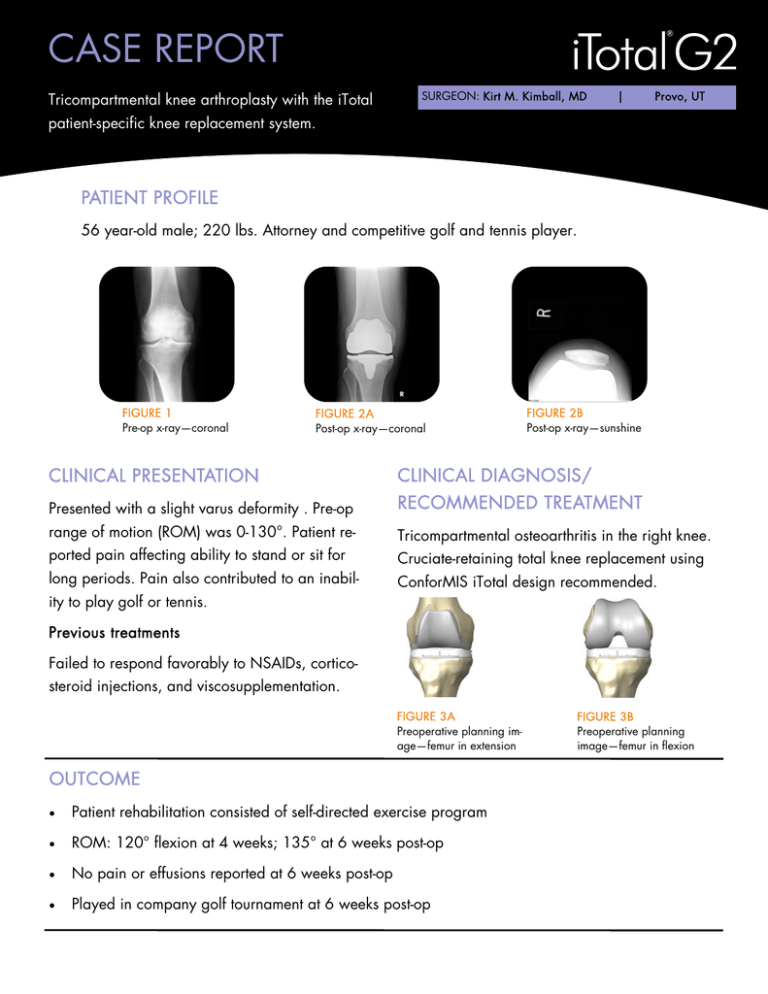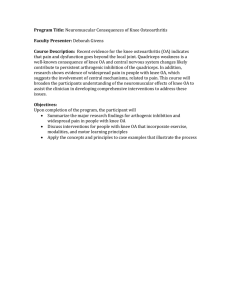iTotal case study_Kimball_3.12.13.pub
advertisement

CASE REPORT Tricompartmental knee arthroplasty with the iTotal SURGEON: Kirt M. Kimball, MD | Provo, UT patient-specific knee replacement system. PATIENT PROFILE 56 year-old male; 220 lbs. Attorney and competitive golf and tennis player. FIGURE 1 Pre-op x-ray—coronal FIGURE 2A Post-op x-ray—coronal FIGURE 2B Post-op x-ray—sunshine CLINICAL PRESENTATION CLINICAL DIAGNOSIS/ Presented with a slight varus deformity . Pre-op RECOMMENDED TREATMENT range of motion (ROM) was 0-130°. Patient re- Tricompartmental osteoarthritis in the right knee. ported pain affecting ability to stand or sit for Cruciate-retaining total knee replacement using long periods. Pain also contributed to an inabil- ConforMIS iTotal design recommended. ity to play golf or tennis. Previous treatments Failed to respond favorably to NSAIDs, corticosteroid injections, and viscosupplementation. FIGURE 3A Preoperative planning image—femur in extension OUTCOME Patient rehabilitation consisted of self-directed exercise program ROM: 120° flexion at 4 weeks; 135° at 6 weeks post-op No pain or effusions reported at 6 weeks post-op Played in company golf tournament at 6 weeks post-op FIGURE 3B Preoperative planning image—femur in flexion ConforMIS, Inc. · 28 Crosby Drive, Bedford, MA 01730 · Phone: 781.345.9001 · Fax: 781.345.0147 www.conformis.com INDICATIONS The iTotal G2 Knee Replacement System (KRS) is intended for use as a total knee replacement in patients with knee joint pain and disability whose conditions cannot be solely addressed by the use of a prosthetic device that treats only one or two of the three knee compartments, such as a unicondylar, patellafemoral or bicompartmental prosthesis. The Indications for Use include: • Painful joint disease due to osteoarthritis, traumatic arthritis or rheumatoid arthritis or osteonecrosis of the knee. • Post traumatic loss of joint function. • Moderate varus, valgus or flexion deformity in which the ligamentous structures can be returned to adequate function and stability. • Failed osteotomies, hemiarthoplasties, and unicondylar, patellafemoral or bicompartmental implants. • Revision procedures provided that anatomic landmarks are necessary for alignment and positioning of the implants are identifiable on patient imaging scans. CONTRAINDICATIONS The following conditions are absolute contraindications for tricompartmental knee repair. • Active or recent local or systemic infection. • Insufficient bone stock on the femoral or tibial surfaces. • Skeletal immaturity. • Loss of bone or musculature, osteoporosis, neuromuscular or vascular compromise in the area of the joint to be operated to an extent that the procedure is unjustifiable (e.g., absence of musculoligamentous supporting structures, joint neuropathy). • Severe instability due to advanced loss of osteochondral structure or the absence of collateral ligament integrity. • Severe (>15 degrees) fixed valgus or varus deformity. • Metal sensitivity (e.g., nickel). The iTotal G2 implant is intended for cemented use only. Authorized Representative Medical Device Safety Service, GMBH Schiffgraben 41, 30175 Hannover, Germany Phone: +49 (511) 6262.8630 Fax: +49 (511) 6262.8633 Prior to using any ConforMIS device, please review the instructions for use and surgical technique for a complete listing of indications, contraindications, warnings, precautions and directions for use. CAUTION: USA federal law restricts this device to sale by or on the order of a physician. The ConforMIS iTotal G2 is intended for use only by medically trained physicians. MK-02790-AA 03/13 | © 2013. ConforMIS, Inc.


